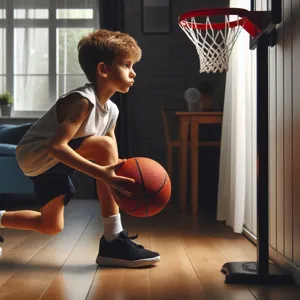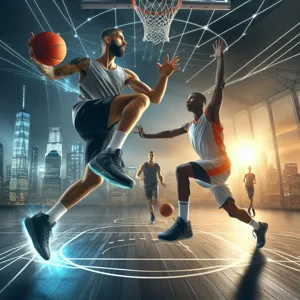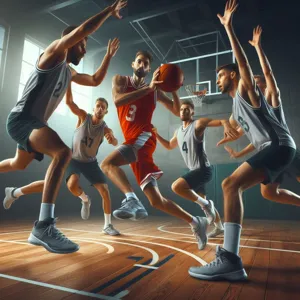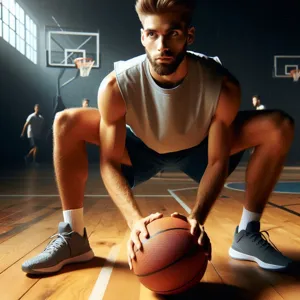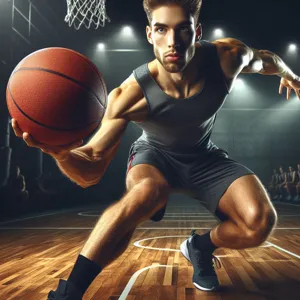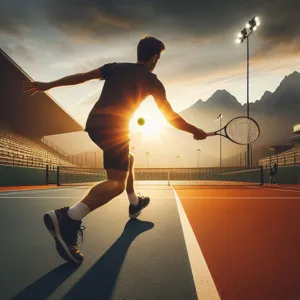Whether you’re a seasoned player looking to refine your skills or a beginner eager to learn the fundamentals, practicing basketball with a friend can turn a mundane workout into a fun and engaging experience.
The beauty of the game lies not only in its competitive spirit but also in the camaraderie it fosters on and off the court. In this blog post, we will explore ten exciting and effective basketball drills that you can try with a buddy, designed to enhance your shooting accuracy, improve ball handling, and elevate your overall gameplay. These drills are not only beneficial for skill development but are also a great way to bond, challenge each other, and bring out your competitive edge. So grab your basketball gear, find a friend, and get ready to elevate your game while enjoying the thrill of teamwork and friendly rivalry!
1. Introduction: The Importance of Drills in Basketball

Basketball is more than just a game; it’s a dance of skill, strategy, and teamwork. Whether you’re a seasoned player or just starting out, honing your abilities through drills is essential for improvement and success on the court. Drills serve as the building blocks of good basketball fundamentals, enhancing your shooting accuracy, ball-handling skills, and defensive techniques. Engaging in regular practice not only sharpens individual talents but also fosters better communication and synergy with your teammates.
But drills don’t have to be monotonous or solitary! When you grab a friend and incorporate fun into your training sessions, you transform the grind of practice into an enjoyable bonding experience. You challenge each other, push your limits, and perhaps even ignite a bit of friendly competition. From dribbling to shooting and defensive maneuvers, the right drills can elevate your game while keeping your sessions lively and engaging.
In this post, we’ll explore ten fun and effective basketball drills you can try with a friend. These activities are designed to not only improve your skills but also to create lasting memories on the court. So lace up your sneakers, grab a basketball, and get ready to take your game to the next level!
2. Warm-Up: Stretching and Basic Ball Handling
Before diving into intense basketball drills, it’s crucial to start with a proper warm-up. Engaging in stretching and basic ball handling not only prepares your body for the physical demands of the game but also enhances your overall performance. Begin with a series of dynamic stretches to loosen up your muscles and improve flexibility. Focus on exercises that target your legs, arms, and core—think leg swings, arm circles, and torso twists. These movements increase blood flow and reduce the risk of injury, setting the stage for an effective training session.
Once your muscles are warmed up, transition into basic ball-handling drills. This is where you and your friend can sharpen your coordination and control. Start with simple dribbling exercises, alternating between your dominant and non-dominant hands. Challenge each other to maintain control while moving through cones or around designated markers. Try performing crossovers, behind-the-back dribbles, and hesitation moves to keep things interesting.
Incorporate passing drills as well; practice chest passes, bounce passes, and overhead passes while on the move. This not only enhances your handling skills but also fosters teamwork and communication between you and your partner. By combining stretching and ball handling, you’ll not only warm up physically but also mentally prepare yourselves for the fun and competitive drills that follow. So lace up your shoes, grab your basketball, and get ready to elevate your game!
3. Dribble Relay Race: Boosting Speed and Agility

The dribble Relay Race is a high-energy drill that not only enhances your dribbling skills but also injects a sense of friendly competition into your practice sessions. This drill is perfect for two players looking to improve their speed and agility while having a blast on the court.
To set up, you’ll need a basketball, a marked course, and two cones or markers to designate the start and finish lines, spaced about 15 to 20 feet apart. Once the course is set, position yourself and your friend at the starting line, basketball in hand, ready to put your skills to the test.
On the count of three, both players will dribble towards the finish line as quickly as possible. The goal here is to maintain control of the ball while sprinting, which will push you to enhance your dribbling technique under pressure. As you race back and forth, focus on using both hands, keeping your head up to maintain awareness of your surroundings, and employing quick changes of direction to navigate the course effectively.
To make it even more challenging, you can introduce obstacles such as cones to weave around or designate specific moves, like crossovers or behind-the-back dribbles, that you must execute while racing. Not only does this drill help in improving your foot speed and coordination, but it also fosters teamwork and encourages a bit of playful rivalry.
After a few rounds, keep track of your times and see who can complete the relay the fastest. This friendly competition will motivate both players to push harder and hone their skills, making the Dribble Relay Race a fun and effective way to elevate your basketball game while building camaraderie with your friend.
4. Spot Shooting Challenge: Improving Accuracy
The Spot Shooting Challenge is not just a drill; it’s a test of skill that can turn any casual shooting session into a competitive and fun experience. To set up this drill, you’ll need just a basketball and a hoop—preferably in a gym or on a well-maintained outdoor court. You’ll start by selecting five designated spots around the perimeter of the three-point arc—these could include the corners, the wings, and the top of the key. Each player takes turns shooting from these spots, aiming to make as many shots as possible within a set time limit, say 60 seconds.
What makes this challenge particularly effective is its focus on accuracy. The act of shooting from specific spots encourages players to refine their shooting form, develop consistency, and gain confidence in their range. You can spice things up by introducing a point system—assigning different point values for shots made from various distances, or even incorporating a “bank shot” rule, where players earn extra points for using the backboard.
As you and your friend engage in this friendly competition, you’ll not only enhance your shooting skills but also foster a sense of camaraderie and motivation. Celebrate each other’s successes, share tips on form and technique, and keep track of your scores to see who comes out on top. Over time, you’ll notice significant improvements in your shooting accuracy, making this drill a must-try for any aspiring basketball player looking to elevate their game. Plus, the thrill of competition will keep you both coming back for more, turning practice into an enjoyable challenge every time you hit the court together.
5. One-on-One Defense Drill: Enhancing Defensive Skills

The One-on-One Defense Drill is an essential exercise designed to sharpen your defensive skills while providing a fun and competitive environment for you and your friend. This drill not only helps improve your individual defensive techniques but also enhances your understanding of positioning and footwork on the court.
To start, designate a half-court area, ensuring there’s enough space for both players to move freely. One player will take on the role of the offensive player, while the other assumes the defensive stance. The offensive player begins with the ball at the three-point line, while the defender positions themselves between the ball and the basket, adopting a low defensive stance with knees bent and hands up to challenge any potential shots.
As the offensive player dribbles toward the basket, your goal as the defender is to stay in front of them, utilizing quick lateral movements and maintaining a low center of gravity. Focus on your footwork—slide your feet rather than crossing them over, which allows for better balance and quicker reactions. Encourage your friend to use a variety of moves, including crossovers, behind-the-back dribbles, and spins, to challenge your defensive skills.
After a set amount of time or a predetermined number of attempts, switch roles. This not only gives both players the chance to work on their offensive and defensive skills but also fosters a sense of camaraderie and friendly competition. To elevate the drill, you can introduce specific scoring methods, such as awarding points for successful defensive stops or offensive maneuvers.
Incorporating the One-on-One Defense Drill into your practice routine will not only enhance your defensive prowess but also build essential basketball instincts—helping both you and your friend become more effective players on the court. Plus, the competitive nature of the drill guarantees plenty of laughs and a great workout!
6. Passing Drills: Strengthening Teamwork and Communication
Passing drills are a fundamental aspect of basketball that not only enhance your skills but also strengthen the bond between you and your training partner. Effective passing is crucial for teamwork, and practicing together can significantly improve both communication and coordination on the court.
One great drill to try is the “Two-Ball Passing” exercise. Stand about 10 feet apart from your partner, each holding a basketball. As you pass the ball back and forth, alternate between bounce passes, chest passes, and overhead passes. This drill will not only increase your accuracy and speed but will also challenge your ability to think on your feet. As you progress, try increasing the distance between you or adding movement by dribbling towards each other before making the pass.
Another exciting option is the “Pass and Move Drill.” In this drill, one player stands at the three-point line while the other starts near the basket. The player at the three-point line passes the ball to the player near the basket, who then immediately cuts to the perimeter to receive the ball back. This drill emphasizes quick decision-making and encourages your partner to continuously move and find open space, simulating real-game scenarios.
For an added layer of complexity, consider implementing a time limit or keeping score based on successful passes. This friendly competition will not only make the drills more engaging but will also help you both develop a deeper understanding of each other’s play styles.
Remember, the key to mastering passing is communication. Use verbal cues to signal when you’re ready for the ball or if you’re about to make a cut. Over time, you’ll find that the synergy you build through these drills will translate to better teamwork in actual games, making you both more effective players on the court. So grab a friend, hit the court, and have fun enhancing your passing skills together!
7. Layup Lines with a Twist: Adding Variations for Fun

Layup lines are a classic warm-up drill that helps players refine their finishing skills around the basket. However, adding a twist to this fundamental exercise can inject an extra layer of excitement and challenge into your practice sessions. Instead of simply running through the motions, consider incorporating variations that not only improve technique but also make the drill more engaging for you and your friend.
Start with the traditional layup, but then spice things up by introducing different types of layups. For instance, alternate between right-handed and left-handed layups, forcing each player to work on their weaker side. This not only enhances versatility but also helps in developing ambidexterity, a valuable asset on the court.
Next, add a time constraint. Set a timer for one minute and see how many layups each player can make in that timeframe. This creates a friendly competition and adds an element of urgency, encouraging you both to push your limits. To further complicate things, try incorporating dribble moves before the layup. Have one player perform a crossover or a spin move at the three-point line before driving to the basket for the layup. This variation simulates game-like scenarios, helping you practice decision-making and agility under pressure.
For an even more dynamic twist, introduce a “defender” element. One player takes on the role of a defender as the other attempts to finish the layup. This not only develops offensive skills but also challenges the defender to improve their positioning and timing, creating a well-rounded practice experience.
By infusing these variations into your layup lines, you’ll not only refine your skills but also keep the energy high and the practice enjoyable. The key is to stay creative and find ways to challenge each other, ensuring that both players leave the court feeling accomplished and energized. So grab a ball, a friend, and get ready to enjoy some fun-filled layup lines with a twist!
8. Free Throw Competition: Building Pressure Situations
The Free Throw Competition is not just about sinking shots; it’s a thrilling way to simulate high-pressure game situations while honing your skills. Gather your friend and head to the free-throw line—where the stakes are high, and every shot counts. To kick things off, set a time limit and determine how many free throws each of you will take, perhaps ten or twenty. But here’s the twist: introduce a competitive edge by keeping score of each successful basket.
As you both take turns shooting, you’ll quickly feel the intensity rise. The pressure of knowing your friend is watching—and competing—can bring a new level of focus to your technique. Each missed shot becomes a lesson in resilience and concentration, while each swish serves as a confidence booster. To ramp up the challenge even further, consider adding fun penalties for missed shots. For example, the player with the lowest score at the end of the round could do a set number of push-ups or sprints, turning the drill into a game of endurance as well as skill.
This competition not only sharpens your free-throw shooting but also fosters a spirit of camaraderie and friendly rivalry. It’s an excellent opportunity to practice mental toughness, as you learn to block out distractions and perform under pressure. Plus, the laughter and banter that come from competing with a friend make this drill enjoyable, ensuring that you both walk away with improved skills and a memorable experience on the court.
9. Around the World: A Fun Shooting Game
Around the World is a classic shooting game that adds a playful twist to your basketball practice while sharpening your shooting skills. This drill not only enhances accuracy but also introduces a competitive element that can make practice sessions more enjoyable.
To begin, find a basketball court and set up several shooting spots around the three-point line, often referred to as “stations.” Each station should be spaced evenly, typically at five- to seven-foot intervals. The first player starts at the designated starting point, taking their shot from that location. If they make the basket, they move to the next station. If they miss, they must await their turn again and attempt the shot from the same spot.
As your friend takes their turn, you can cheer them on or offer friendly banter to keep the energy high. The goal is to make it “around the world” by successfully shooting from all the designated spots without missing. If a player misses at any point, they must return to the starting position, which adds a layer of suspense and excitement to the drill.
For an added challenge, consider introducing a rule where players have to call their shots—meaning they have to predict which spot they will make the basket from before shooting. This encourages focus and intent, while also making the game more interactive.
Around the World is not just about shooting; it also fosters teamwork and camaraderie as you and your friend share laughs, celebrate successful shots, and motivate each other to improve. Plus, it’s a great way to break up the monotony of standard drills, keeping your practice sessions fresh and engaging. So grab a basketball and head to the court; it’s time to take your shooting skills to new heights!
10. Fast Break Practice: Transitioning from Defense to Offense
Fast break practice is an exhilarating and essential drill that sharpens your ability to transition swiftly from defense to offense, mimicking the pace and intensity of real-game scenarios. This drill not only enhances your speed and agility but also improves your teamwork and decision-making skills on the court.
To set up the fast break practice, start by positioning one player on each end of the court—one as the defender and the other as the offensive player. The drill begins with the defender attempting to steal the ball or force a turnover. Once the defensive player gains possession, the real excitement begins. They must quickly dribble the ball towards the opposite end of the court, while the offensive player hustles back to transition into a defender.
As the offensive player sprints to catch up, the focus is on making quick decisions—should they pass the ball, take a shot, or drive towards the basket? Meanwhile, the defender must work on their footwork and positioning, striving to close the gap and contest any potential shots. This dynamic exchange not only boosts cardiovascular fitness but also encourages players to communicate effectively, fostering a sense of camaraderie and teamwork.
To make the drill even more engaging, you can introduce variations, such as allowing the offensive player to make a specific number of passes before they attempt a shot, or setting a time limit to simulate game pressure. By incorporating fast break practice into your training sessions, you and your friend will sharpen your skills while enjoying the thrill of the game, ensuring you’re both prepared to make those crucial plays when it counts.
11. Rebounding Drill: Focusing on Positioning and Timing
Rebounding is often the unsung hero of basketball, yet it plays a pivotal role in determining the outcome of a game. The Rebounding Drill is designed to enhance your skills in positioning and timing, two crucial aspects that can set apart a good player from a great one. Grab a friend, hit the court, and prepare to elevate your game.
To begin, one player will take a shot from various spots on the court while the other player positions themselves as a rebounder. The shooter can use different shot types—layups, jump shots, or three-pointers—to simulate real-game scenarios. As the shooter releases the ball, the rebounder must immediately focus on their positioning. They should anticipate the ball’s trajectory and establish an advantageous position between their opponent and the basket.
Timing is equally essential. The rebounder should practice jumping at the right moment—just as the ball reaches its peak height—for maximum elevation. Encourage your friend to vary their shot angles and distances, compelling you to adjust your positioning and timing accordingly. This not only builds your physical skills but also sharpens your basketball IQ as you learn to read the shooter’s body language and predict where the ball will land.
To add an extra layer of competition, keep track of how many rebounds each player secures during a set period. This friendly rivalry will fuel motivation and make the drill more engaging. Remember, the goal of this drill is not just to collect rebounds but also to develop a keen sense of spatial awareness and reaction time—skills that will undoubtedly translate into improved performance on the court. With consistent practice, you and your friend will find yourselves dominating the boards and giving your team a significant edge in any game!
12. Cool Down: Reflection and Stretching
After an intense session of drills and scrimmages, it’s crucial to wind down properly, and that’s where the cool-down phase comes into play. Not only does it allow your body to transition from the rigorous activity back to a state of rest, but it also provides an opportunity for reflection and bonding with your basketball buddy.
Start with some gentle jogging or walking around the court to help lower your heart rate gradually. This simple act keeps the blood flowing to your muscles, aiding in recovery and preventing stiffness. Once your heart rate has stabilized, transition into a series of static stretches. Focus on key muscle groups that worked hard during your drills: your calves, quadriceps, hamstrings, shoulders, and back.
As you stretch, take the time to chat with your friend about the session. Discuss the drills that felt most effective, the skills you both improved on, and areas that might need more focus in future practices. This reflection not only reinforces learning but also strengthens your connection, making the sessions more enjoyable and productive.
Consider incorporating some partner stretches, where you can help each other reach deeper into those stretches while maintaining a bit of camaraderie. For example, one easy stretch is the seated toe touch, where you sit facing each other, legs extended, and reach for each other’s hands while trying to touch your toes. This not only stretches your lower back and hamstrings but also adds a fun dynamic to the cool-down process.
Conclude your cool-down with a few minutes of deep breathing exercises. Inhale deeply through your nose, allowing your diaphragm to expand, and then exhale slowly through your mouth. This practice not only helps calm your nervous system but also reinforces the importance of mindfulness in sports.
By incorporating a cool-down routine that emphasizes reflection and stretching, you and your friend can enhance your overall basketball experience, ensuring that you leave the court feeling accomplished and ready for the next challenge.
13. Tracking Progress: How to Measure Improvement
Tracking your progress is essential in any sport, and basketball is no exception. To truly understand how you’re improving, you need to establish clear metrics. This not only keeps you motivated but also provides tangible evidence of your hard work and dedication. Here are some effective strategies to measure your improvement on the court.
First, consider keeping a detailed training log. Document each drill you practice, noting the number of repetitions, duration, and any specific targets you aim to achieve. For instance, if you’re working on shooting drills, record your shooting percentage, distance from the basket, and types of shots taken. Over time, you’ll be able to look back and see how your skills have developed.
Another method is to set specific performance goals. Whether it’s hitting a certain number of three-pointers in a row or completing a particular dribbling drill within a set time frame, having concrete objectives gives you something to strive for. Make sure these goals are SMART—Specific, Measurable, Achievable, Relevant, and Time-bound—to ensure they are effective.
Incorporating video analysis can also be a game-changer. Ask a friend to film your practice sessions, or set up your phone to capture your drills. Watching the footage allows you to observe your form, footwork, and overall technique, providing insights that might be missed in the heat of the moment. You can compare videos over weeks or months to visually track your growth.
Lastly, don’t forget to incorporate feedback from your training partner. They can provide valuable insights into your strengths and areas for improvement based on their observations. Regular discussions about your performance will not only help you stay accountable but also create a supportive environment for mutual growth.
By adopting these methods to track your progress, you’ll cultivate a deeper understanding of your development as a basketball player. This awareness will not only fuel your motivation but also enhance your skill set, ensuring that you and your friend continue to challenge each other and enjoy the game even more.
14. Conclusion: The Benefits of Practicing with a Friend
In conclusion, practicing basketball with a friend not only enhances your skills on the court but also enriches the overall experience of the game. When you and a partner work together, the benefits are manifold. Firstly, having a practice buddy introduces an element of accountability; you’re less likely to skip a session when you know someone is counting on you. This shared commitment can lead to more consistent practice, ultimately translating into improved performance during games.
Moreover, practicing with a friend fosters a friendly competitive spirit. You can push each other to try harder, refine your techniques, and explore new drills that you might not tackle alone. This dynamic can lead to enhanced skill development, as you learn from each other’s strengths and weaknesses. Whether it’s perfecting your shooting form or honing your defensive strategies, the insights gained from a partner can be invaluable.
Additionally, the social aspect of practicing with a friend cannot be overlooked. Basketball is as much about camaraderie and teamwork as it is about individual prowess. Sharing laughter, celebrating successes, and even learning from mistakes together can deepen your bond, making every session enjoyable. Plus, the more fun you have, the more motivated you’ll be to keep coming back to the court.
Incorporating these fun and effective drills into your practice routine with a friend will not only sharpen your basketball skills but also create lasting memories and a stronger friendship. So grab a ball, hit the court, and make the most of your practice time together!
15. Bonus: Tips for Staying Motivated and Having Fun
When it comes to basketball, staying motivated and having fun should always go hand in hand. After all, the sport is not just about perfecting your skills but also about enjoying the time spent on the court with friends. Here are some tips to keep the energy high and the motivation flowing during your practice sessions.
**Set Fun Goals Together:** Instead of solely focusing on winning or achieving specific stats, create lighthearted challenges with your friend. Whether it’s seeing who can make the most three-pointers in a row or who can sink a shot from the farthest distance, these friendly competitions can spark excitement and keep both of you engaged.
**Mix Up Your Drills:** Repeating the same drills can become monotonous. Keep things fresh by incorporating a variety of drills into your practice. Alternate between shooting, dribbling, and defensive exercises, or even invent your own fun drills that might include elements from other sports. The variety will not only enhance your skills but also keep the practice sessions lively.
**Celebrate Small Wins:** Acknowledge each other’s progress, no matter how small. Whether it’s nailing a tricky shot or mastering a new dribble move, celebrating these achievements fosters a positive atmosphere. Consider doing a fun celebration dance or a high-five whenever one of you accomplishes a goal. This boosts motivation and reinforces the joy of learning.
**Incorporate Music:** Music can be a great motivator. Create a playlist of your favorite upbeat tracks to play while you practice. The right tunes can elevate your mood and energy levels, making every drill feel less like work and more like a fun workout.
**Stay Positive and Encouraging:** Keep the vibe upbeat by offering encouragement and support to one another. A word of praise or a simple “you’ve got this!” can go a long way in keeping spirits high, especially when the drills get tough. Remember, the goal is to enjoy the process while honing your skills.
**Schedule Regular Playdates:** Consistency is key, but so is having something to look forward to. Set regular practice dates that fit both of your schedules, and treat them like important appointments. This commitment not only helps with accountability but also builds anticipation for your time on the court together.
By blending skill development with fun, you can create a practice routine that keeps both you and your friend energized and engaged. Remember, basketball is as much about camaraderie as it is about competition, so embrace the joy of the game and keep pushing each other to improve!
In conclusion, incorporating these 10 fun and effective basketball drills into your practice sessions can transform not only your skills but also the way you enjoy the game. Whether you’re honing your shooting accuracy, improving your dribbling agility, or enhancing your teamwork, these drills are designed to boost your performance while fostering a fun and competitive spirit with a friend. Remember, the key to growth in any sport is consistency and creativity in your practice routine. So grab a ball, hit the court, and make the most of your time together—who knows, you might just discover a new favorite drill! Happy training, and may your shots be ever swish!




